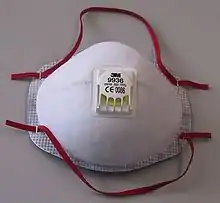Source control (respiratory disease)
Source control is a strategy for reducing disease transmission by blocking respiratory secretions produced through speaking, coughing, sneezing[1] or singing.[2] Surgical masks are commonly used for this purpose, with cloth face masks recommended for use by the public only in epidemic situations when there are shortages of surgical masks.[3][4] In addition, respiratory etiquette such as covering the mouth and nose with a tissue when coughing can be considered source control.[3] In diseases transmitted by droplets or aerosols, understanding air flow, particle and aerosol transport may lead to rational infrastructural source control measures that minimize exposure of susceptible persons.[5]

Mechanisms

Infections in general may spread by direct contact (for example, shaking hands or kissing), by inhaling infectious droplets in the air (droplet transmission), by inhaling long-lasting aerosols with tiny particles (airborne transmission), and by touching objects with infectious material on their surfaces (fomites). Different diseases spread in different ways; some spread by only some of these routes. For instance, fomite transmission of COVID-19 is thought to be rare while aerosol, droplet and contact transmission appear to be the primary transmission modes, as of April 2021.[7]
Coughs and sneezes can spread airborne droplets up to ~8 meters (26 ft). Speaking can spread droplets up to ~2 meters (6.6 ft).[6] It may be difficult to maintain these distances. For a masked person, or even one sneezing or coughing into a tissue or elbow, these distances are reduced.[8]
Masking any person who may be a source of infectious droplets (or aerosols) thus reduces the unsafe range of physical distances. If a person can be infectious before they are symptomatic and diagnosed, then people who do not yet know if they are infectious may also be a source of infection.
Handwashing helps to protect people against contact transmission, and against indirect droplet transmission. Handwashing removes infectious droplets that their mask caught (from either side) and which transferred to their hands when they touched their mask.[6]
For pathogens transmitted through the air, strategies to block cough air jets and to capture aerosols, e.g. the "Shield & Sink" approach, can be highly effective in minimizing exposure to respiratory secretions.[5]
Contrast with personal protective equipment

While source control protects others from transmission arising from the wearer, personal protective equipment protects the wearer themselves.[9] Cloth face masks can be used for source control but are not considered personal protective equipment[1][9] as they have low filter efficiency (generally varying between 2–60%), although they are easy to obtain and reusable after washing.[3][10] There are no standards or regulation for self-made cloth face masks.[3]
Surgical masks are designed to protect against splashes and sprays,[4] but do not provide complete respiratory protection from germs and other contaminants because of the loose fit between the surface of the face mask and the face.[11] Surgical masks are regulated by various national standards to have high bacterial filtration efficiency (BFE).[12][13][14] N95/N99/N100 masks and other filtering facepiece respirators can provide source control in addition to respiratory protection, but respirators with an unfiltered exhalation valve may not provide source control and require additional measures to filter exhalation air when source control is required.[4]
| Type | Source control | Inhaled air filtration | Ref |
|---|---|---|---|
| Cloth face mask | [1][3][9] | ||
| Surgical mask or procedure mask | [4][11] | ||
| Respirator without exhalation valve | [4] | ||
| Respirator with unfiltered exhalation valve | [4] | ||
| Respirator with filtered exhalation valve | [4] |
COVID-19 pandemic
During the COVID-19 pandemic, cloth face masks for source control have been recommended by the U.S. Centers for Disease Control and Prevention (CDC) for members of the public who leave their homes, and health care facilities are commended to consider requiring face masks for all people who enter the facility. Health care personnel and patients with COVID-19 symptoms are recommended to use surgical masks if available, as they are more protective.[15] Masking patients reduces the personal protective equipment recommended by CDC for health care personnel under crisis shortage conditions.[16]
The World Health Organization and European Centre for Disease Prevention and Control recommend face masks in non-healthcare community settings in severe epidemic situations with a high prevalence of asymptomatic but infectious persons, especially when visiting crowded indoor spaces such as grocery stores, public transportation, and for certain workers who must come into physical proximity with many other people.[3]
References
- "FAQs on the Emergency Use Authorization for Face Masks (Non-Surgical)". U.S. Food and Drug Administration. 2020-04-26. Retrieved 2020-05-21.
- Naunheim, Matthew R.; Bock, Jonathan; Doucette, Philip A.; Hoch, Matthew; Howell, Ian; Johns, Michael M.; Johnson, Aaron M.; Krishna, Priya; Meyer, David; Milstein, Claudio F.; Nix, John (2020-06-28). "Safer Singing During the SARS-CoV-2 Pandemic: What We Know and What We Don't". Journal of Voice. 35 (5): 765–771. doi:10.1016/j.jvoice.2020.06.028. ISSN 0892-1997. PMC 7330568. PMID 32753296.
- "Using face masks in the community - Reducing COVID-19 transmission from potentially asymptomatic or pre-symptomatic people through the use of face masks". European Centre for Disease Prevention and Control. 2020-04-08. Retrieved 2020-05-21.
- "Interim Infection Prevention and Control Recommendations for Patients with Suspected or Confirmed Coronavirus Disease 2019 (COVID-19) in Healthcare Settings". U.S. Centers for Disease Control and Prevention. 2020-05-18. Retrieved 2020-05-21.
- Hunziker, Patrick (2020-12-16). "Minimizing exposure to respiratory droplets, 'jet riders' and aerosols in air-conditioned hospital rooms by a 'Shield-and-Sink' strategy". medRxiv: 2020.12.08.20233056. doi:10.1101/2020.12.08.20233056. S2CID 229291099.
- Sommerstein, R; Fux, CA; Vuichard-Gysin, D; Abbas, M; Marschall, J; Balmelli, C; Troillet, N; Harbarth, S; Schlegel, M; Widmer, A; Swissnoso. (6 July 2020). "Risk of SARS-CoV-2 transmission by aerosols, the rational use of masks, and protection of healthcare workers from COVID-19". Antimicrobial Resistance and Infection Control. 9 (1): 100. doi:10.1186/s13756-020-00763-0. ISSN 2047-2994. PMC 7336106. PMID 32631450.
- Carbone, Michele; Lednicky, John; Xiao, Shu-Yuan; Venditti, Mario; Bucci, Enrico (2021). "Coronavirus 2019 Infectious Disease Epidemic: Where We Are, What Can be Done and Hope for". Journal of Thoracic Oncology. 16 (Carbone M, Lednicky J, Xiao SY, Venditti M, Bucci E. Coronavirus 2019 Infectious Disease Epidemic: Where We Are, What Can Be Done and Hope For. J Thorac Oncol. 2021 Apr, 16(4):546-571. doi: 10.1016/j.jtho.2020.12.014. Epub 2021 Jan 7. PMID: 33422679, PMCID: PMC7832772): 546–571. doi:10.1016/j.jtho.2020.12.014. PMC 7832772. PMID 33422679.
- Tang, JW; Nicolle, AD; Pantelic, J; Jiang, M; Sekhr, C; Cheong, DK; Tham, KW (2011). "Qualitative real-time schlieren and shadowgraph imaging of human exhaled airflows: an aid to aerosol infection control". PLOS ONE. 6 (6): e21392. Bibcode:2011PLoSO...621392T. doi:10.1371/journal.pone.0021392. PMC 3120871. PMID 21731730. (see video on Wikimedia Commons)
- "Meat and Poultry Processing Workers and Employers: Interim Guidance from CDC and the Occupational Safety and Health Administration (OSHA)". Centers for Disease Control and Prevention. 2020-05-12. At section "Cloth face coverings in meat and poultry processing facilities". Retrieved 2020-05-24.
- Rengasamy S, Eimer B, Shaffer RE (2010). "Simple Respiratory Protection—Evaluation of the Filtration Performance of Cloth Masks and Common Fabric Materials Against 20–1000 nm Size Particles". Annals of Occupational Hygiene. Oxford University Press. 54 (7): 789–798. doi:10.1093/annhyg/meq044. ISSN 0003-4878. PMC 7314261. PMID 20584862.
The results showed that cloth masks and other fabric materials tested in the study had 40–90% instantaneous penetration levels against polydisperse NaCl aerosols employed in the National Institute for Occupational Safety and Health particulate respirator test protocol at 5.5 cm s−1.
- "N95 Respirators and Surgical Masks (Face Masks)". U.S. Food and Drug Administration. 2020-04-05. Retrieved 2020-05-23.
- Robertson, Paddy (15 March 2020). "Comparison of Mask Standards, Ratings, and Filtration Effectiveness". Smart Air Filters.
- 中华人民共和国医药行业标准:YY 0469–2011 医用外科口罩 (Surgical mask) (in Chinese)
- 中华人民共和国医药行业标准:YY/T 0969–2013 一次性使用医用口罩 (Single-use medical face mask) (in Chinese)
- "Interim Infection Prevention and Control Recommendations for Patients with Suspected or Confirmed Coronavirus Disease 2019 (COVID-19) in Healthcare Settings". U.S. Centers for Disease Control and Prevention. 2020-05-18. Retrieved 2020-05-21.
- "Strategies for Optimizing the Supply of N95 Respirators". U.S. Centers for Disease Control and Prevention. 2020-04-02. At section "Prioritize the use of N95 respirators and facemasks by activity type". Retrieved 2020-05-21.